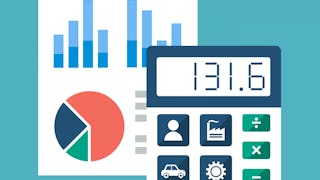The core of the first course is to learn how companies record total costs and calculate unit costs for their individual products or services. For example, how can a car manufacturer figure out the costs of an individual car series? During the first weeks, participants learn what costs are and how to distinguish them from expenses or cash flows. Participants will understand how companies record total costs and distinguish important cost types such as material costs, personnel costs, or depreciation. At the core of their cost-accounting system, companies allocate overhead costs to individual products. We show participants how to allocate the costs incurred to the company's products and introduce them to the most important methods and challenges of product costing.


Basics of Cost Accounting: Product Costing
This course is part of Cost Accounting Specialization



Instructors: Gunther Friedl
18,945 already enrolled
Included with
(180 reviews)
Recommended experience
What you'll learn
You will learn how to make your company's cost structure transparent and how to record and calculate costs.
You will learn methods of product costing, i.e., how companies calculate costs of their products and services.
You will learn to decide which product costing system is most suitable for your company’s production program and production type.
You will learn how to determine overhead rates for the allocation of overhead costs to products.
Skills you'll gain
Details to know

Add to your LinkedIn profile
34 assignments
See how employees at top companies are mastering in-demand skills

Build your subject-matter expertise
- Learn new concepts from industry experts
- Gain a foundational understanding of a subject or tool
- Develop job-relevant skills with hands-on projects
- Earn a shareable career certificate

There are 4 modules in this course
Welcome to Cost Accounting! In this module, we will introduce you to the basic concepts of cost accounting. You will learn what cost accounting is and how cost accounting relates to corporate accounting. Thereafter, you will get familiar with some basic cost terms that are essential for cost accountants. Finally, we will introduce you to a framework that distinguishes three sub-systems of cost accounting. This framework will guide us through the following modules.
What's included
9 videos6 readings3 assignments1 discussion prompt1 plugin
In this module, we will introduce you to cost-type accounting - the first of the three cost accounting sub-systems. Cost-type accounting helps companies to make their cost structure transparent. It gives companies an overview of which costs have been incurred. We will take a closer look at three important cost items namely material costs, personnel costs, and machine costs. You will learn how companies record and calculate them.
What's included
8 videos5 readings7 assignments
In this module, we will dive into cost-center accounting. Cost-center accounting creates transparency about where, i.e. in which cost center, the overhead costs of a company have been incurred. It connects cost-type accounting with product costing by performing three allocation steps: First, overhead costs from cost-type accounting are assigned to cost centers. However, ultimately cost accountants want to assign the costs to cost objects. Because this is easier for costs of production-related cost centers ("direct cost centers") than for costs of "indirect cost centers" such as the IT or the canteen, companies allocate overhead costs from indirect to direct cost centers first. Finally, they determine overhead rates for the allocation of overhead costs from direct cost centers to cost objects. In this module, we will introduce you to each of these steps.
What's included
10 videos2 readings11 assignments
In this module, we introduce you to product and service costing. Product and service costing provides companies with information about the costs of individual products or services. It is the final of the three cost accounting sub-systems. We will sometimes just refer to product and service costing as "product costing", but of course some companies offer physical products while others offer services. We explain how companies design product costing systems and we make you familiar with important methods of product costing. We also discuss how well the costing methods are suited for different production processes and program types. To this end, we will distinguish "job shop production" and "mass and batch production".
What's included
12 videos3 readings13 assignments1 discussion prompt3 plugins
Earn a career certificate
Add this credential to your LinkedIn profile, resume, or CV. Share it on social media and in your performance review.
Instructors

Offered by
Explore more from Finance

Coursera
 Status: Free Trial
Status: Free TrialTechnical University of Munich (TUM)
 Status: Free Trial
Status: Free TrialTechnical University of Munich (TUM)
 Status: Preview
Status: PreviewUniversity of Virginia
Why people choose Coursera for their career




Learner reviews
180 reviews
- 5 stars
75%
- 4 stars
19.44%
- 3 stars
3.33%
- 2 stars
0.55%
- 1 star
1.66%
Showing 3 of 180
Reviewed on Dec 22, 2024
Concise and precise. Need to improve on the detailing part (in-depth).
Reviewed on May 7, 2023
An insightful course into the basics of cost accounting
Reviewed on Mar 9, 2022
Great course! Very informative and easy to follow, but still challenging.

Open new doors with Coursera Plus
Unlimited access to 10,000+ world-class courses, hands-on projects, and job-ready certificate programs - all included in your subscription
Advance your career with an online degree
Earn a degree from world-class universities - 100% online
Join over 3,400 global companies that choose Coursera for Business
Upskill your employees to excel in the digital economy
Frequently asked questions
To access the course materials, assignments and to earn a Certificate, you will need to purchase the Certificate experience when you enroll in a course. You can try a Free Trial instead, or apply for Financial Aid. The course may offer 'Full Course, No Certificate' instead. This option lets you see all course materials, submit required assessments, and get a final grade. This also means that you will not be able to purchase a Certificate experience.
When you enroll in the course, you get access to all of the courses in the Specialization, and you earn a certificate when you complete the work. Your electronic Certificate will be added to your Accomplishments page - from there, you can print your Certificate or add it to your LinkedIn profile.
Yes. In select learning programs, you can apply for financial aid or a scholarship if you can’t afford the enrollment fee. If fin aid or scholarship is available for your learning program selection, you’ll find a link to apply on the description page.
More questions
Financial aid available,


